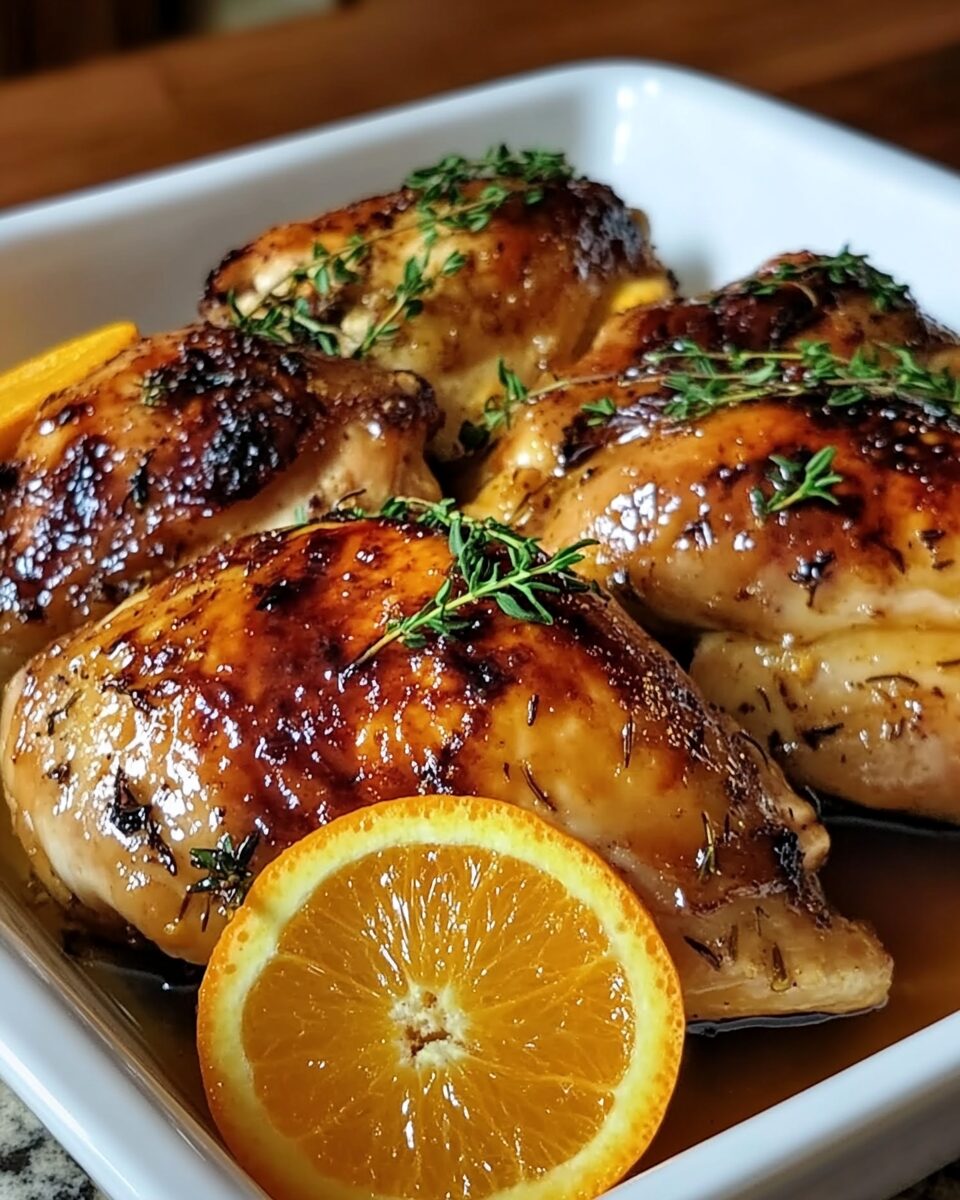Roasted Orange Chicken is a flavorful and comforting main dish that combines the juicy tenderness of whole roasted chicken with a bright, citrusy glaze made from fresh orange juice, zest, honey, soy sauce, and Dijon mustard. Balanced with herbs like rosemary and thyme, this meal is perfect for family dinners, special occasions, or holidays. It’s easy to prepare, visually impressive, and incredibly delicious.
Full Recipe:
Ingredients
-
1 whole chicken (4–5 lbs)
-
2 tbsp olive oil
-
1 tbsp garlic, minced
-
1 tbsp fresh thyme, chopped
-
1 tbsp fresh rosemary, chopped
-
Zest and juice of 2 large oranges
-
1 tbsp honey
-
1 tbsp soy sauce
-
1 tsp Dijon mustard
-
Salt and pepper, to taste
-
1 small onion, quartered
-
1 cup chicken broth
-
2 tbsp butter (optional)
Directions
-
Preheat Oven: Set to 400°F (200°C).
-
Prep Chicken: Pat dry. Rub with olive oil, garlic, thyme, rosemary, salt, and pepper.
-
Make Glaze: Mix orange zest and juice, honey, soy sauce, and Dijon mustard.
-
Stuff Chicken: Insert onion quarters into the cavity.
-
Roast Chicken: Place chicken in a roasting pan, breast side up. Add broth around it.
-
Glaze: Brush chicken with glaze. Roast for 1 hour, basting with glaze halfway through.
-
Finish: Roast until golden and internal temp reaches 165°F (75°C).
-
Rest & Serve: Let rest for 10 minutes before carving. Serve with remaining glaze or pan juices.
Nutrients (Per serving, approx.)
-
Calories: 350–400 kcal
-
Protein: 35g
-
Fat: 22g
-
Carbohydrates: 20g
The Citrus Twist That Elevates a Classic
What sets Roasted Orange Chicken apart from traditional roast chicken is its zesty glaze. Orange juice adds natural brightness and acidity, while the zest infuses the skin and meat with intense citrus aroma. Honey lends a soft sweetness that caramelizes in the oven, creating a lacquered finish, while Dijon mustard and soy sauce round out the flavors with tang and umami.
This unique combination of ingredients brings balance to the richness of the chicken and creates a dynamic flavor profile that is savory, sweet, slightly spicy, and deeply aromatic. The glaze doesn’t overpower the dish—instead, it enhances the chicken’s natural juiciness and introduces a refreshing burst of flavor with every bite.
Why Whole Chicken Works Best
Using a whole chicken not only delivers more flavor and moisture, but it also makes for an impressive presentation. Roasting a whole bird allows the different cuts—breast, thighs, wings—to cook together, each developing a slightly different texture and flavor. The dark meat becomes especially juicy and tender, while the breast remains moist thanks to the basting process and the protective layer of citrus glaze.
A whole chicken is also budget-friendly and versatile. Leftovers can be used for sandwiches, salads, or soup the next day, and the carcass can be saved to make homemade broth.
Flavorful, Fragrant, and Family-Friendly
One of the beauties of Roasted Orange Chicken is its wide appeal. The orange glaze is complex yet familiar, with flavors that resonate with both kids and adults. The herbs add a rustic depth, and the glossy, golden skin entices everyone to dig in.
The scent that fills the kitchen while it’s roasting is reason enough to try this dish. Citrus, herbs, garlic, and roasted chicken aromas blend into a warm, inviting fragrance that promises a satisfying meal. It’s the kind of dish that feels celebratory without needing a special occasion to justify making it.
Easy Preparation for Impressive Results
Despite its sophisticated appearance and taste, this dish is surprisingly simple to prepare. Most of the work involves creating the orange glaze and seasoning the chicken, both of which take only minutes. Once in the oven, it requires minimal attention—just an occasional basting to lock in flavor and encourage even browning.
Roasting at 400°F ensures a crispy, golden exterior while sealing in the juices. The glaze reduces and thickens in the heat, creating a naturally sticky coating that clings to the chicken. Stuffing the cavity with onion enhances internal moisture and adds subtle sweetness to the meat from the inside out.
The Power of Herbs and Aromatics
Thyme and rosemary, two aromatic herbs often used in poultry recipes, lend earthy, piney, and slightly floral notes that complement the citrus. Garlic, always a flavor enhancer, rounds out the profile with warmth and richness. These simple ingredients work together to deepen the complexity of the glaze and elevate the chicken to restaurant-quality status.
You can use fresh or dried herbs, but fresh herbs are preferred here for their more vibrant flavor. As the chicken roasts, the oils from the rosemary and thyme infuse the meat and the glaze, enhancing each bite.
Perfect Pairings and Serving Suggestions
Roasted Orange Chicken pairs wonderfully with a variety of sides. For a comforting and hearty meal, serve it with garlic mashed potatoes or roasted sweet potatoes. The sweet and tangy glaze also complements buttery rice pilaf, quinoa, or wild rice beautifully.
For lighter options, consider steamed green beans with lemon, sautéed kale, or a crisp arugula salad with citrus vinaigrette. You can even slice the chicken and serve it cold over salad greens for a refreshing next-day lunch.
For a complete citrus-themed meal, pair this chicken with a white wine like Chardonnay or Riesling. Both complement the glaze’s sweetness and acidity while cutting through the chicken’s richness.
Tips for Success
To ensure juicy results and maximum flavor, follow a few key steps. Always pat the chicken dry before seasoning—it helps the skin crisp up during roasting. When making the glaze, whisk thoroughly to dissolve the honey and evenly distribute the flavors. Brush generously onto the chicken before roasting and again halfway through to build that gorgeous, sticky crust.
Roast the chicken uncovered to allow browning, but if it starts to darken too much before it’s fully cooked, loosely tent it with foil. Be sure to check that the internal temperature of the thickest part of the thigh reaches 165°F to guarantee it’s cooked through.
Letting the chicken rest for at least 10 minutes before carving allows the juices to redistribute, keeping every bite tender and moist.
Make-Ahead and Leftover Ideas
Roasted Orange Chicken is excellent for meal prep or next-day meals. You can make the glaze a day ahead and store it in the fridge. Rub the chicken with oil and herbs ahead of time to let the seasoning soak in overnight.
Leftovers can be enjoyed in a variety of ways: shredded into wraps with fresh greens and a yogurt-based citrus dressing, added to stir-fries, or even tossed into fried rice. The glaze also doubles as a marinade or stir-fry sauce, so it’s worth making a little extra to keep on hand.
Nutritional Value and Health Benefits
This dish is rich in lean protein and offers a healthier alternative to fried or cream-heavy chicken dishes. Each serving contains around 350 to 400 calories and 35 grams of protein, making it a filling yet balanced main course.
Oranges are naturally high in vitamin C and antioxidants, which help support immune function and reduce inflammation. The herbs, garlic, and olive oil bring their own health benefits, including heart-healthy fats and antimicrobial properties.
To reduce sodium, opt for low-sodium soy sauce or decrease the salt added before roasting. You can also increase the vegetable ratio on the plate to keep the meal lighter and fiber-rich.
A Dish for All Seasons
Whether it’s a cozy winter dinner, a festive holiday spread, or a springtime Sunday roast, Roasted Orange Chicken fits the occasion. Its bright citrus notes make it feel light and fresh, while the roasted chicken base provides warmth and comfort. The vibrant colors and enticing aroma also make it a beautiful centerpiece for gatherings.
Because the recipe is adaptable, you can also experiment with other citrus fruits like lemon, tangerine, or blood orange for a unique twist. Add spices like cinnamon or chili flakes for added depth and warmth, or drizzle the glaze with a touch of balsamic reduction for extra tang.
Conclusion
Roasted Orange Chicken is a shining example of how simple ingredients, when thoughtfully combined, can create a meal that’s flavorful, nourishing, and unforgettable. With its golden, crispy skin, tender meat, and bold citrus glaze, it satisfies all the senses and brings joy to the dinner table.
Whether you’re preparing it for a family gathering, a holiday celebration, or a regular weeknight dinner, this dish delivers comfort and elegance in every bite. It’s easy enough for beginners yet refined enough for seasoned cooks to take pride in. Once you experience the harmony of orange, herbs, and perfectly roasted chicken, you’ll understand why this dish deserves a spot in your regular rotation.

